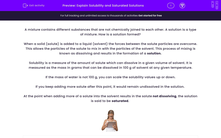A mixture contains different substances that are not chemically joined to each other. A solution is a type of mixture. How is a solution formed?
When a solid (solute) is added to a liquid (solvent) the forces between the solute particles are overcome. This allows the particles of the solute to mix in with the particles of the solvent. This process of mixing is known as dissolving and results in the formation of a solution.
Solubility is a measure of the amount of solute which can dissolve in a given volume of solvent. It is measured as the mass in grams that can be dissolved in 100 g of solvent at any given temperature.
If the mass of water is not 100 g, you can scale the solubility values up or down.
If you keep adding more solute after this point, it would remain undissolved in the solution.
At the point when adding more of a solute into the solvent results in the solute not dissolving, the solution is said to be saturated.








